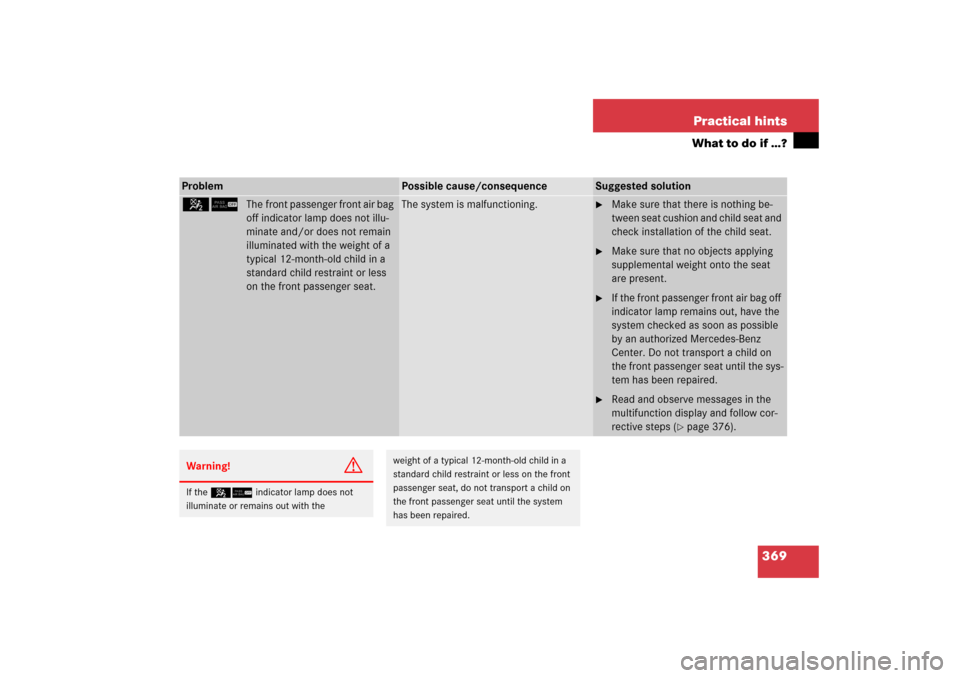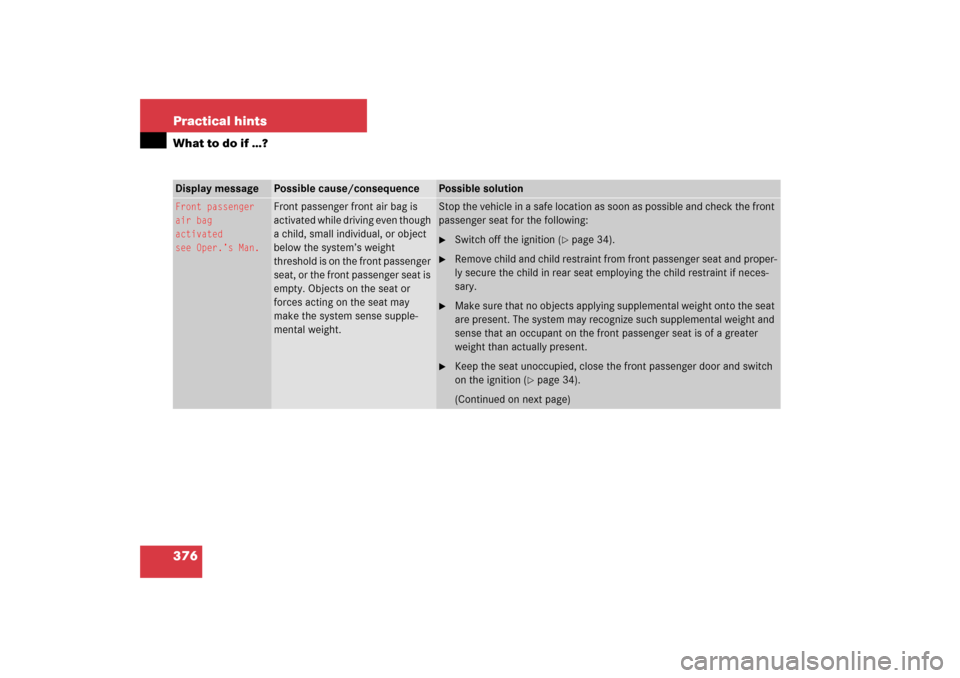Page 370 of 489

369 Practical hints
What to do if …?
Problem
Possible cause/consequence
Suggested solution
56
The front passenger front air bag
off indicator lamp does not illu-
minate and/or does not remain
illuminated with the weight of a
typical 12-month-old child in a
standard child restraint or less
on the front passenger seat.
The system is malfunctioning.
�
Make sure that there is nothing be-
tween seat cushion and child seat and
check installation of the child seat.
�
Make sure that no objects applying
supplemental weight onto the seat
are present.
�
If the front passenger front air bag off
indicator lamp remains out, have the
system checked as soon as possible
by an authorized Mercedes-Benz
Center. Do not transport a child on
the front passenger seat until the sys-
tem has been repaired.
�
Read and observe messages in the
multifunction display and follow cor-
rective steps (
�page 376).
Warning!
G
If the 56 indicator lamp does not
illuminate or remains out with the
weight of a typical 12-month-old child in a
standard child restraint or less on the front
passenger seat, do not transport a child on
the front passenger seat until the system
has been repaired.
Page 377 of 489

376 Practical hintsWhat to do if …?Display message
Possible cause/consequence
Possible solution
Front passenger
air bag
activated
see Oper.’s Man.
Front passenger front air bag is
activated while driving even though
a child, small individual, or object
below the system’s weight
threshold is on the front passenger
seat, or the front passenger seat is
empty. Objects on the seat or
forces acting on the seat may
make the system sense supple-
mental weight.
Stop the vehicle in a safe location as soon as possible and check the front
passenger seat for the following:�
Switch off the ignition (
�page 34).
�
Remove child and child restraint from front passenger seat and proper-
ly secure the child in rear seat employing the child restraint if neces-
sary.
�
Make sure that no objects applying supplemental weight onto the seat
are present. The system may recognize such supplemental weight and
sense that an occupant on the front passenger seat is of a greater
weight than actually present.
�
Keep the seat unoccupied, close the front passenger door and switch
on the ignition (
�page 34).
(Continued on next page)
Page 379 of 489
378 Practical hintsWhat to do if …?Display message
Possible cause/consequence
Possible solution
Front passenger
air bag
deactivated
see Oper.’s Man.
Front passenger front air bag is deac-
tivated while driving even though an
adult or someone larger than a small
individual is occupying the front pas-
senger seat. Forces acting on the
seat may make the system sense a
decrease in weight.
Stop the vehicle in a safe location as soon as possible and check the
front passenger seat for the following:�
Switch off the ignition (
�page 34).
�
Have the front passenger vacate the seat and exit the vehicle.
�
Keep the seat unoccupied, close the front passenger door and
switch on the ignition (
�page 34).
(Continued on next page)
Page 425 of 489
424 Practical hintsFlat tire�
Guide spare wheel onto the alignment
bolt and push it on.
�
Insert wheel bolts and tighten them
slightly.
�
Unscrew the alignment bolt, install last
wheel bolt and tighten slightly.Lowering the vehicle
�
Lower vehicle by turning crank
counterclockwise until vehicle is
resting fully on its own weight.
�
Remove the jack.1 - 5Wheel bolts
�
Tighten the five wheel bolts evenly,
following the diagonal sequence
illustrated (1to5), until all bolts are
tight. Observe a tightening torque
of 80 lb-ft (110 Nm).
Warning!
G
Only use Genuine equipment
Mercedes-Benz wheel bolts. Other wheel
bolts may come loose.
Do not tighten the wheel bolts when the
vehicle is raised. Otherwise the vehicle
could fall off the jack.
Warning!
G
Have the tightening torque checked after
changing a wheel. The wheels could come
loose if they are not tightened to a torque
of 80 lb-ft (110 Nm).
��
Page 440 of 489
439 Technical data
Parts service
Warranty coverage
Identification labels
Layout of poly-V-belt drive
Engine
Rims and tires
Electrical system
Main dimensions and weights
Fuels, coolants, lubricants, etc.
Page 452 of 489
451 Technical data
Main dimensions and weights
�Main dimensions and weights
Main dimensionsWeightsModel
CLK 350
CLK 500
Overall vehicle length
183.3 in (4 657 mm)
182.8 in (4 657 mm)
Overall vehicle width (exterior rear view
mirrors folded out)
78.4 in (1 991 mm)
78.4 in (1 991 mm)
Overall vehicle height
55.4 in (1 408 mm)
55.4 in (1 408 mm)
Wheelbase
106.9 in (2 715 mm)
106.9 in (2 715 mm)
Track, front
58.8 in (1 493 mm)
58.9 in (1 497 mm)
Track, rear
58.0 in (1 474 mm)
58.2 in (1 478 mm)
Roof load max.
220 lbs (100 kg)
Trunk load max.
220 lbs (100 kg)
Page 462 of 489

461 Technical terms
ABS
(A
ntilock B
rake S
ystem)
Prevents the wheels from locking up
during braking so that the vehicle can
continue to be steered.
Alignment bolt
Metal pin with thread. The centering
pin is an aid used when changing a tire
to align the wheel with the wheel hub.
Accessory weight
(
�page 342)
Air pressure
(�page 342)
Aspect ratio
(�page 342)
Bar
(�page 342)
BAS
(Brake A
ssist S
ystem)
System for potentially reducing braking
distances in emergency braking situa-
tions. The system is activated when it
senses an emergency based on how
fast the brake is applied.Bead
(
�page 342)
Bi-Xenon headlamps*
Headlamps which use an electric arc as
the light source and produce a more in-
tense light than filament headlamps.
Bi-Xenon headlamps produce low
beam and high beam.
CAC
(Customer A
ssistance C
enter)
Mercedes-Benz customer service cen-
ter, which can help you with any ques-
tions about your vehicle and provide
assistance in the event of a break-
down.
CAN system
(C
ontroller A
rea N
etwork)
Data bus network serving to control ve-
hicle functions such as door locking or
windshield wiping.Cockpit
All instruments, switches, buttons and
indicator/warning lamps in the passen-
ger compartment needed for vehicle
operation and monitoring.
Cold tire inflation pressure
(
�page 342)
COMAND
(Cockpit M
anagement and D
ata Sys-
tem)
Information and operating center for
vehicle sound and communications
systems, including the radio and the
navigation system, as well as other op-
tional equipment (CD changer, tele-
phone, etc.).
Control system
The control system is used to call up
vehicle information and to change
component settings. Information and
messages appear in the multifunction
display. The driver uses the buttons on
the multifunction steering wheel to
navigate through the system and to ad-
just settings.
Page 463 of 489

462 Technical termsCruise control
Driving convenience system for auto-
matically maintaining the vehicle speed
set by the driver.
Curb weight
(
�page 342)
DOT
(Department O
f Transportation)
(
�page 342)
Engine number
The number set by the manufacturer
and placed on the cylinder block to
uniquely identify each engine pro-
duced.
Engine oil viscosity
Measurement for the inner friction (vis-
cosity) of the oil at different tempera-
tures. The higher the temperature an
oil can tolerate without becoming thin,
or the lower the temperature it can tol-
erate without becoming viscous, the
better the viscosity.ESP
®(Electronic S
tability Pr
ogram)
Improves vehicle handling and direc-
tional stability.
ETD
(E
mergency T
ensioning D
evice)
Device which deploys in certain frontal
and rear collisions exceeding the sys-
tem's threshold to tighten the seat
belts.
->SRS
FSS (Canada vehicles)
(F
lexible S
ervice S
ystem)
Maintenance service indicator in the
multifunction display that informs the
driver when the next vehicle mainte-
nance service is due. FSS evaluates en-
gine temperature, oil level, vehicle
speed, engine speed, distance driven
and the time elapsed since your last
maintenance service, and calls for the
next maintenance service accordingly.GAWR
(G
ross A
xle W
eight R
ating)
(
�page 342)
Gear range
Number of gears which are available to
the automatic transmission for shifting.
The automatic gear shifting process
can be adapted to specific operating
conditions using the gear selector le-
ver.
GPS
(Global P
ositioning S
ystem)
Satellite-based system for relaying
geographic location information to and
from vehicles equipped with special re-
ceivers. Employs CD digital maps for
navigation.
GVW
(G
ross V
ehicle W
eight)
(
�page 342)
GVWR
(Gross V
ehicle W
eight R
ating)
(
�page 343)